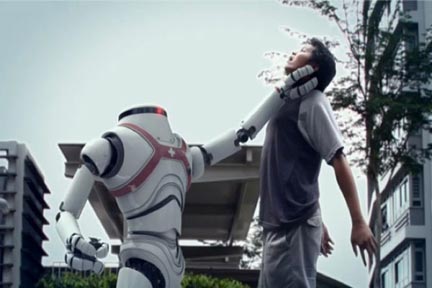The rise of the machines
 Robot
kills man. That was a headline that screamed at me from a website I
opened recently. Alarmed, I quickly glanced through the news item. It
said that a robot involved in car assembly at a VW plant in Germany had
crushed and killed a young assembly line worker. The robot in question
was not 'intelligent' per se, but it was simply acting on a
pre-programmed impulse to grab something. Robot
kills man. That was a headline that screamed at me from a website I
opened recently. Alarmed, I quickly glanced through the news item. It
said that a robot involved in car assembly at a VW plant in Germany had
crushed and killed a young assembly line worker. The robot in question
was not 'intelligent' per se, but it was simply acting on a
pre-programmed impulse to grab something.
Nevertheless, this incident had once again brought to the fore the
perils of working with robots, intelligent or dumb. Major advances have
been made in robotics and Artificial Intelligence (AI) to the point
where some robots can actually manage to 'think' on their own and take
appropriate action. From spherical robots that vacuum our floors to
Rovers exploring other planets in the solar system, robots have indeed
come a long way. One day, they will explore Exoplanets too well before
we do.
Mechanical
|

At the Volkswagen Plant...
Pic courtesy: pakalertpress.com |
Robots have always fascinated us. For many, the word robot conjures
an image of a mechanical being clad in metal, adorned with all sorts of
blinking lights and buttons, and even a funny-sounding voice. Indeed,
such robots have become stock characters in science fictions stories,
novels, films and television shows. Star Wars R2-D2 is a prime example
for a film depiction of a robot while 2001's HAL depicted a computer
which had Artificial intelligence.
More recently, robots - and the derived term robotics - have come to
represent modern engineering technologies for a myriad of functions
ranging from artificial intelligence experiments and building autonomous
automobiles to performing delicate surgical procedures without human
intervention. However, the humanoid robot is alive and well - as
exemplified by Honda's singing, dancing robot ASIMO.
As a word, robot is a relative newcomer to the English language. It
was the brainchild of a brilliant Czech playwright, novelist and
journalist named Karel Capek who introduced it in his 1920 hit play,
R.U.R., or Rossum's Universal Robots. Robot is drawn from an old Church
Slavonic word, robota, for "servitude," "forced labor" or "drudgery."
The word, which also has cognates in German, Russian, Polish and Czech,
was a product of the central European system of serfdom by which a
tenant's rent was paid for in forced labor or service.
Biology
R.U.R. tells the story of a company using the latest biology,
chemistry and physiology to mass produce workers who "lack nothing but a
soul." In the play's final act, the robots revolt against their human
creators. After killing most of the people living on the planet, the
robots realize they need humans because none of them can figure out the
means to manufacture more robots - a secret that dies out with the last
human being.
1. This is precisely what opponents of AI fear - that robots could
one day take over the world. In fact, science fiction writer Isaac
Asimov came out with the famous Three Laws of Robotics having foreseen
the dangers posed by super intelligent machines. The Laws are: A robot
may not injure a human being or, through inaction, allow a human being
to come to harm. A robot must obey orders given it by human beings
except where such orders would conflict with the First Law. A robot must
protect its own existence as long as such protection does not conflict
with the First or Second Law.Alarmed by the "rise of the machines" (to
borrow from a famous movie title), scientists are scrambling to find out
how Man could control super intelligent machines. Already, the CoCoRo
(Collective Cognitive Robotics) Project in Europe has developed robots
with artificial intelligence that can function in unison like a school
of fish. The robots can search an area, scan the environment, and send
information among one another. IBM's Watson, for instance, has become a
prime example of what artificial intelligence can deliver as it has
learned history, facts, and other information, and even won a game on
the popular quiz show "Jeopardy". IBM's Deep Blue Chess Computer was so
good it could beat many Grandmasters. In any case, the concept of AI is
not even new - The idea of a machine-man is seen as early as some of the
Greek Myths, such as the golden "robots" of Hephaestus.
Obsolete
Fears have been expressed that such smart machines can not only take
care of use and run every aspect of our lives but they can also
out-smart us and eventually get rid of us because we are obsolete. Well,
even our phones can now understand certain phrases that we utter, Google
can instantly translate languages and there really is no limit to what
AI can achieve.
SpaceX, PayPal and Tesla pioneer Elon Musk has even come forward to
fund research that should help provide a clearer idea of how humans and
artificial intelligence can work together, such as outlining the ways a
financial AI programme can explain its suggestion for an innovative
investment strategy. They will soon be awarding grants to 37 different
research teams, to be chosen out of 300 applicants, who will then study
a number of current problems within the field of AI - among them, basic
human wants and needs, as well as setting a common ground for the
interests of both robots and humans. The researchers are encouraged to
find ways to prevent any potential catastrophes due to the mushrooming
growth in the technology. However, there is another school of thought
that mankind should not fear AI - that it would never go beyond human
intelligence.
Mechanical
Interestingly, there is a possibility that we could become more like
mechanical robots or cyborgs as they are known. It is already possible
to transplant certain artificial appendages and organs and even
artificial hearts are within the realm of possibility. Just take the
example of Byron Wake, 15, who used a hypodermic syringe to insert a
microchip under the skin on his hand.
The chip enables him to unlock his mobile phone and operate some
Bluetooth devices with a wave of his hand. He is now a cyborg:
part-human, part machine. This is just the start. The future will be
very interesting from an AI and robotics point of view because man and
machine could become one. |

